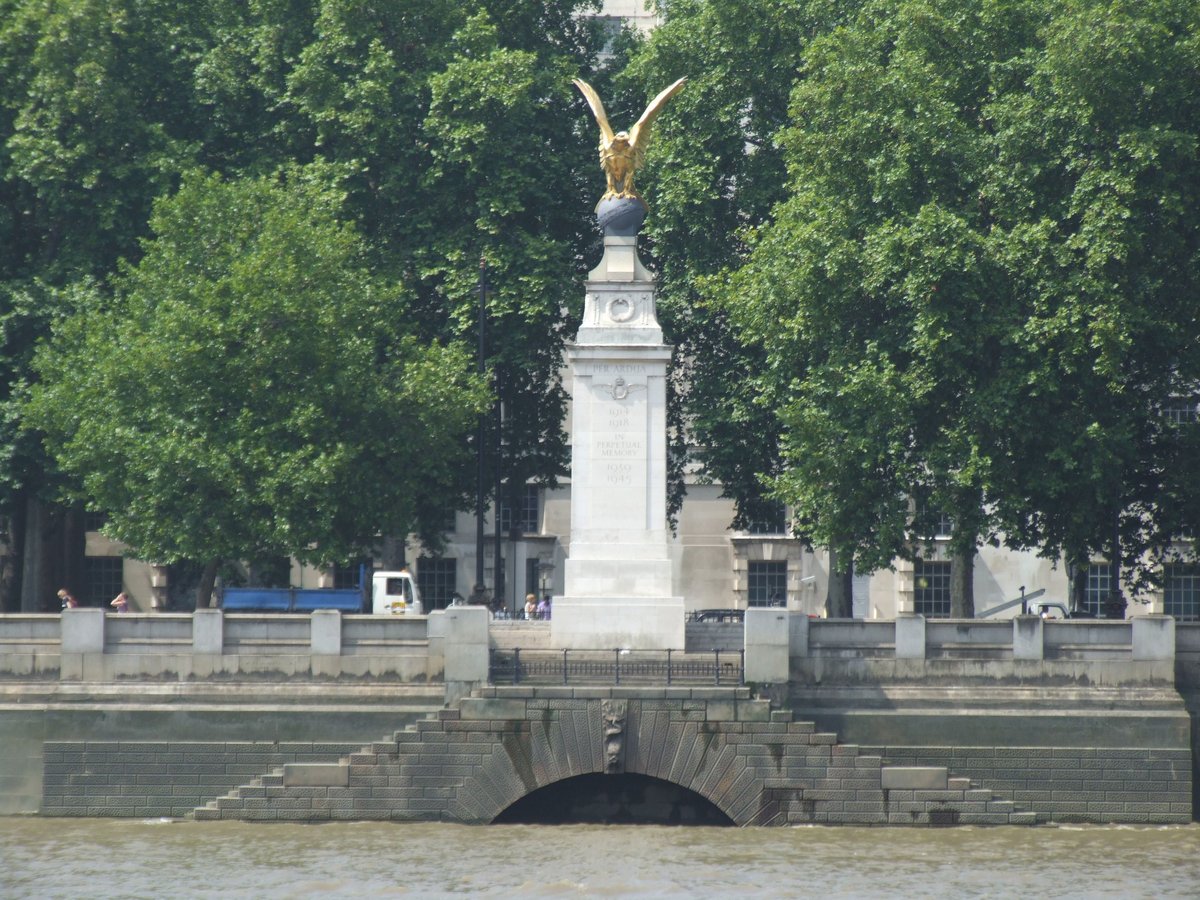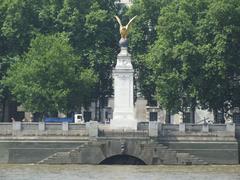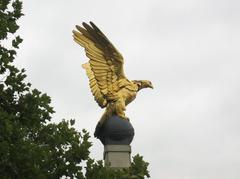
Royal Air Force Memorial London: Visiting Hours, Tickets, and Comprehensive Guide
Date: 15/06/2025
Introduction
The Royal Air Force Memorial in London stands as a powerful symbol of the courage, service, and sacrifice made by RAF personnel and their allied air services during the First and Second World Wars. Prominently located on the Victoria Embankment at Whitehall Steps and overlooking the River Thames, this iconic monument is a key destination for those interested in military history, British heritage, and London’s architectural landmarks. Designed by Sir Reginald Blomfield and unveiled in 1923, the memorial features a soaring Portland stone pylon crowned by a gilded bronze eagle by Sir William Reid Dick. This guide provides detailed information on the memorial’s history, architectural details, symbolism, practical visitor advice—including visiting hours, accessibility, and nearby attractions—and highlights its significance as a site of remembrance and national pride.
For further details and planning your visit, consult resources such as the RAF Benevolent Fund, C20 Society, and Stories of London.
Table of Contents
- Historical Background
- Visiting the Royal Air Force Memorial
- Nearby Attractions
- Symbolism and Cultural Impact
- Frequently Asked Questions (FAQs)
- Tips for a Memorable Visit
- References and Further Reading
Historical Background
Origins and Motivation
The idea for the Royal Air Force Memorial emerged shortly after World War I, in response to the formation of the RAF in 1918 and the subsequent desire to honor those who lost their lives in aerial warfare. Initial proposals considered a chapel, but financial and logistical constraints led to the decision to create a freestanding monument along the Thames (Wikipedia, RAF Benevolent Fund PDF).
Design and Construction
Renowned architect Sir Reginald Blomfield, also responsible for the Menin Gate, was commissioned to design the memorial. The structure features:
- A 15-meter Portland stone pylon: Chosen for its durability and association with British monumental architecture.
- A gilded bronze eagle by William Reid Dick: With a wingspan of approximately 2.5 meters, the eagle stands atop a darkly patinated bronze globe, symbolizing the global reach of the RAF and its readiness to take flight.
- RAF Insignia and Motto: The Latin phrase “PER ARDUA AD ASTRA” (“Through adversity to the stars”) encircles the monument, encapsulating the ethos of the RAF (C20 Society, Britain Express).
Unveiling and Later Inscriptions
The memorial was unveiled on 16 July 1923 by the Prince of Wales. After World War II, inscriptions were added to honor all RAF and Commonwealth air force personnel who died in subsequent conflicts. The principal dedication reads:
- “1914/1918 IN PERPETUAL MEMORY 1939/1945”
- Additional dedications honor the air forces of the British Commonwealth and Empire (Wikipedia).
Heritage Status and Preservation
Designated as a Grade II listed structure in 1958 and upgraded to Grade II* in 2018, the memorial is recognized for its national and architectural significance. Preservation is overseen by heritage bodies, with regular maintenance supported by the RAF Benevolent Fund and the War Memorials Trust (Historic England, War Memorials Online).
Visiting the Royal Air Force Memorial
Location and Directions
- Address: Whitehall Steps, Victoria Embankment, London WC2R 2PN
- Nearest Underground Stations: Embankment (Bakerloo, Northern, Circle, District lines), Westminster, and Charing Cross—all within a 5–10 minute walk.
- Bus Routes: Multiple lines serve the Victoria Embankment and Whitehall.
- Train: Charing Cross mainline station is nearby.
- Cycling and Walking: The area is accessible via pedestrian paths and cycle lanes; Santander Cycles docking stations are close by.
- By Car: The memorial is within the Congestion Charge Zone; parking is limited—public transport is recommended (Transport for London).
Visiting Hours and Admission
- Hours: Open 24 hours, 7 days a week, year-round.
- Admission: Free. No tickets or reservations required (Stories of London).
Accessibility
- Wheelchair Access: The memorial is situated on a level, paved section of the Embankment, suitable for wheelchair users and visitors with limited mobility.
- Visual Accessibility: Inscriptions are large and clear, but there are no braille panels; assistance is advised for visually impaired visitors.
- Rest Areas: Benches nearby provide seating.
- Restrooms: No facilities on-site; the nearest public toilets are at Embankment Gardens and Charing Cross Station.
Facilities and Amenities
- Food and Drink: Numerous cafes, restaurants, and shops are nearby, particularly along the Strand and in Covent Garden.
- Shelter: The memorial is outdoors; visitors should dress for the weather.
Photography Tips
- Best Lighting: Early morning and late afternoon provide optimal conditions for capturing the gilded eagle and pylon against the Thames.
- Recommended Angles: Riverside views highlight the dramatic backdrop of the Thames and South Bank landmarks.
Events and Guided Tours
- Annual Ceremonies: The memorial hosts key events such as Battle of Britain Day (15 September) and Remembrance Sunday in November, with public wreath-laying and commemorative gatherings (RAF Benevolent Fund).
- Tours: While there are no dedicated guided tours at the monument, many London war memorial walking tours include it as a stop. The Battle of Britain Heritage Walk is a notable self-guided route (BBM Heritage Walk).
Nearby Attractions
The memorial’s central location provides easy access to:
- Fleet Air Arm Memorial: Dedicated to Royal Navy aviation.
- Battle of Britain Monument: Celebrates the pilots of the Battle of Britain.
- St. Clement Danes Church: The RAF’s central church.
- Westminster Abbey Battle of Britain Chapel: For those interested in further RAF history.
- Other Landmarks: Houses of Parliament, London Eye, Trafalgar Square, Covent Garden, and Embankment Gardens (Stories of London).
Symbolism and Cultural Impact
The memorial embodies:
- The Eagle: A universal symbol of courage, vigilance, and flight—reflecting the RAF’s ethos.
- The Globe: Represents the global reach and responsibility of the RAF.
- Portland Stone Pylon: Connects the monument to broader traditions of British commemorative architecture.
- Inscriptions: The Latin motto and dedications reinforce themes of perseverance, sacrifice, and aspiration.
The memorial’s riverside setting and architectural prominence make it a focal point for national remembrance, education, and reflection (Historic England, C20 Society).
Frequently Asked Questions (FAQs)
Q: What are the opening hours for the Royal Air Force Memorial?
A: The memorial is outdoors and open 24/7, every day of the year.
Q: Is there an admission fee or do I need a ticket?
A: No, visiting the memorial is free and does not require a ticket.
Q: Is the site wheelchair accessible?
A: Yes, the memorial is on a flat, paved section of the Embankment and is accessible to wheelchairs.
Q: What is the nearest public transport?
A: Embankment and Charing Cross Underground stations are closest; Charing Cross is the nearest mainline station.
Q: Are guided tours available?
A: While there are no specific tours for the memorial, it is included in many walking tours focused on London’s war memorials and the Whitehall area.
Q: When are the main commemorative events held?
A: Major ceremonies are held on Battle of Britain Day (15 September) and Remembrance Sunday in November.
Tips for a Memorable Visit
- Visit early in the morning or late in the evening for a quieter atmosphere and the best light for photography.
- Dress in layers and bring a waterproof jacket to prepare for London’s changing weather.
- Explore the Embankment on foot to discover other war memorials and green spaces.
- Show respect and maintain a contemplative demeanor as this is a site of remembrance.
- Check the RAF Benevolent Fund for details on upcoming events.
References and Further Reading
- Wikipedia: Royal Air Force Memorial
- RAF Benevolent Fund PDF: RAF Memorial History and Description
- Britain Express: Royal Air Force Memorial
- Historic England: War Memorials to Airmen Listed to Mark Centenary of RAF
- War Memorials Online: Royal Air Force Memorial
- C20 Society: London Royal Air Force Memorial
- RAFM Guide: Royal Air Force Memorial
- Airfield Research Group: War Memorials to Airmen Listed to Mark Centenary of the Royal Air Force
- Stories of London: Royal Air Force Memorial
- Transport for London
- BBM Heritage Walk
- Happy to Wander: London Travel Tips
- Dream Big Travel Far Blog: London Travel Tips
- RAF Benevolent Fund: Bomber Command Memorial Visit





















































































































































































































































